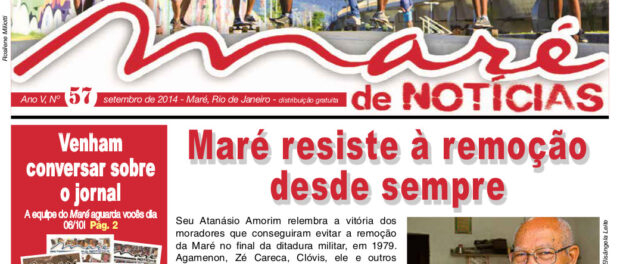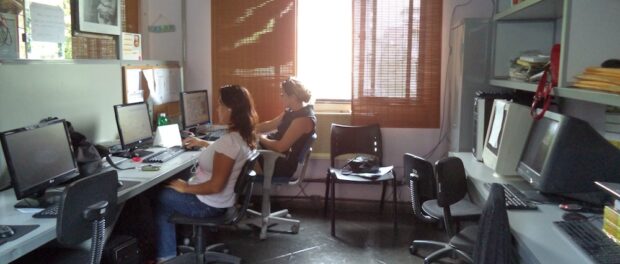
Check out the complete Series of community media profiles here.
Sixteen communities. 130,000 residents. 40,000 newspaper copies. These kinds of numbers demand a highly organized operational strategy, and that is just what Silvia Noronha and Luiz Gonzaga have. On a mid-September Friday afternoon, Gonzaga has come to the single-room office where the editorial staff of Maré de Notícias work to find Noronha, the newspaper’s director. The two of them are reviewing the Excel spreadsheet that breaks down the number of newspapers that will go to each Complexo da Maré community and details a plan of action. The 40,000 copies of the September issue stand waiting for Gonzaga downstairs in the entrance to the Maré Development Network’s (Redes de Desenvolvimento da Maré) immaculate three-story office and classroom complex, painted in the distinctive lilac that identifies the NGO’s several properties dotted around the neighborhood. The stacks of newspapers would tower over most children.
Gonzaga’s distribution team drive as a group to each community and then split up to deliver the paper house by house, street by street. The team estimates it delivers the paper to about 85% of Complexo da Maré’s households. “The distributors are strong members of the team, very important,” Noronha says. “Because they go from house to house, they pass people in the street who ask for the newspaper, who want to comment on something, who want to offer suggestions for content.” Other residents visit the Redes office or email the editorial office directly to voice their feedback. Noronha chuckles as she recounts how the publication of a story focusing on one of Maré’s sixteen communities will inevitably lead residents of another community to contact the newspaper to say: “But here, we have that too!” Thus the content of each issue spurs enthusiasm and ideas for future editions.
Like its peer community newspaper in Maré, O Cidadão, Maré de Notícias is built on the notion that community input should be fundamental in shaping the publication’s direction. It is run by Redes de Desenvolvimento da Maré, or “Redes,” a community-based organization dedicated to the structural transformation of Maré through projects that promote education, culture, employment, and an end to violence.

Before founding the monthly newspaper in 2009, the NGO conducted a survey to learn more about residents’ reading habits. The research found that nine out of ten residents read newspapers and wanted to read news about their own community. However, many survey respondents complained about the way in which the favelas of Maré were treated by the mainstream media. They still wanted information on the problematic events and trends happening in their communities, but they did not want to read reports laden with stereotypes about Maré and favelas in general. A principal objective of the community newspaper, then, is to combat the stigmas that appear frequently in mainstream news.
Redes also designed Maré de Notícias to address respondents’ wish “to see more residents in the newspaper.” Accordingly, feature articles in the September 2014 issue range from interviews with two older residents who reflect on arriving in Maré in 1952 and resisting eviction efforts in the 1970s respectively, to a report on the increasing popularity of the skateboard as a means of transport and leisure in the community.
Survey respondents also wanted to hear more about the favelas’ positive stories, and some mentioned they wanted to see more jokes and recipes. In the September issue, news about local personalities feature heavily, such as the retirement notice of a postman who has delivered mail in the community for more than 30 years and who jokes that dogs do not like postmen because they never bring them letters. The paper also includes a humorous cartoon with a dig at the public health system, a recipe for anti-parasite shampoo, and notices for upcoming cultural events.

Driving the publication is a four-person editorial team, three of whom are residents of the favela complex. In addition to Noronha, the core team is comprised of two other journalists and one photographer, with an intern providing extra support. A quick scan through any issue, however, reveals that many more people contribute articles and images to the newspaper. The back page, in particular, is called “Open Space” (“Espaço Aberto”) and calls for drawings, photos, poems, jokes, recipes and other materials from residents.
The newspaper’s team is responsible for managing social media platforms, although the Facebook page and Twitter account exist under the name of Redes rather than the newspaper specifically. Likewise, the newspaper itself does not have a corresponding website, but the full issues can be viewed on the organization’s website. The online channels mix news pertaining to Maré’s communities overall with updates and events pertaining specifically to the NGO’s activities. This is a marked difference from the newspaper, which does not emphasize Redes’ projects. Noronha gives a simple explanation for this editorial decision: “The newspaper does not belong to Redes. It belongs to the community.”
That said, the newspaper benefits immensely from Redes’ established connections with a variety of funders. In particular, Brazilian energy company Petrobras and international NGO ActionAid have given significant financial support to the paper. Funds cover graphics and printing costs, the distribution process, and remuneration for staff members.
Although securing funding is always a challenge, December will mark five years since Maré de Notícias’ founding and Noronha acknowledges that the ability to sustain a community media vehicle over time is a “privilege.” She points to the recent research conducted by partner organization Observatório de Favelas that found that over two-thirds of surveyed community and alternative media vehicles had never had funding. Even news blogs with low operational costs demand intense time commitments. To commit to media work without pay, as many people who work with community media vehicles do, is an immense challenge that threatens the sustainability and development of these initiatives.
The process of sustaining Maré de Notícias so far has been one of regular revision, continually shaping and then reshaping its content to attract more readers with varied interests. Noronha and her team approach their work with the belief that “it is a characteristic of community communication to always be changing,” embracing the need to change alongside their rapidly changing community. As long as they are pushing forward the critical public debate to end favela stigma, the editorial team is willing to be led forward by their readers.
For more information visit Redes de Desenvolvimento da Maré’s website, or follow its news on Facebook or Twitter.
Check out the complete Series of community media profiles here.
